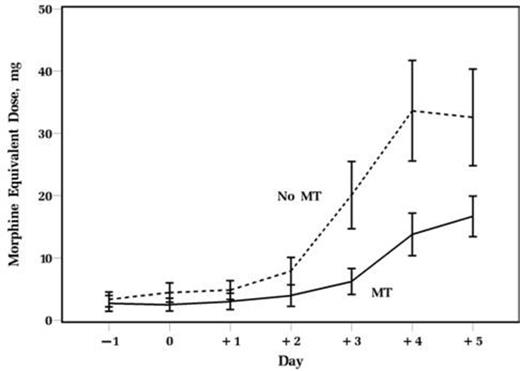Abstract
High-dose chemotherapy followed by autologous stem cell transplant (ASCT) is frequently performed in patients with hematologic malignancies. ASCT can result in significant nausea, pain, and discomfort. Supportive care has improved and pharmacologic therapies are frequently employed, but with limitations. Music therapy has been demonstrated to improve nausea and pain in patients undergoing chemotherapy, but little data are available in the transplant setting. We present Results from a randomized study of music therapy in patients undergoing ASCT.
Patients with lymphoma or multiple myeloma undergoing ASCT were randomized to receive either interactive music therapy (MT) with a board-certified music therapist or no music therapy (No MT). The MT arm received two music therapy sessions: the first occurring as close to Day +1 as possible, the second occurring 48-96 hours later (listed as Day +1 and Day +5). Primary outcomes were perception of pain and nausea, measured on a visual analog scale which ranged from 0 to 10 (0 = no nausea, 10 = worst nausea). These were measured before and after the first music therapy session or at comparable interval for No MT patients and on days +5 and +7. Secondary outcomes were narcotic pain medication use, with pain medication doses converted to morphine equivalents and assessed daily from Day -1 to Day +5. Mood disturbance assessed by Profile of Mood States (POMS). POMS has six scales: depression, vigor, anger, tension, confusion, and fatigue. Categorical variables were compared between arms using Chi-square test, continuous variables were compared using Wilcoxon rank sum test. Repeat measures analysis of variance was used to compare outcomes between study arms over time.
Eighty-two patients were enrolled: MT 37 patients, No MT 45 patients. MT arm had more African American patients (16% vs. 2%, p = 0.02), but otherwise patient characteristics in terms of age, gender, disease type, and preparative regimen were balanced. (Table 1). There was no difference in nausea between MT and No MT arms for Days 1 and +5, however, by Day +7, the MT arm had more nausea than the No MT arm (mean score 2.1 vs. 1.1, P=0.03). Although there was no difference in pain between MT and No MT patients, MT patients required significantly less morphine equivalent over the 7 study days (median 24mg vs 73mg, p =0.03). (Figure 1 and 2). There was no difference between arms for depression, vigor, anger, tension, confusion, or fatigue.
In conclusion, despite having similar pain scores between both groups, the patients who received MT required significantly less narcotic pain medication use. Future study will focus on impact of music therapy on pain.
Pain assessment
Narcotic medication use
Duong:Celgene: Honoraria, Research Funding. Off Label Use: Approved in the US but not in Europe. Hill:Celgene: Honoraria, Research Funding.
Author notes
Asterisk with author names denotes non-ASH members.




